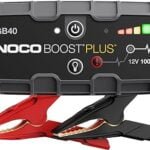Night vision cameras make clear images and videos possible even in total darkness. These cameras use cutting-edge technologies to detect infrared light or increase accessible light, enabling us to see what the human eye cannot. Here, we will discuss almost every aspect of night vision cameras, including their working principles, uses, and common misconceptions.
- How does a night vision camera work?
- Features of a good night-vision camera
- Best night vision cameras available on Amazon
- Frequently asked questions
How does a night vision camera work?
The working of the night vision cameras depends on the type of a night vision camera. Generally, four types of night vision cameras are available in the market based on their working principle.
- Image Intensification
This technology is quite obsolete. It is commonly used in low-cost night vision cameras and devices. It captures the small amount of light available in the environment, including infrared light (which is invisible to the human eye). The resulting image of such cameras is usually green due to the phosphor screen’s properties, providing the iconic green-hued night vision footage (This is why cameras shown in movies usually have green images..!!). - Infrared (IR) Illumination
These cameras use infrared light that is invisible to the human eye> However, it can be detected by the camera’s IR sensors. There are two types of IR technology used:
Active IR cameras come with built-in infrared LEDs illuminating the area in front of the camera. The camera’s sensor detects the reflected IR light and creates a visible image (can be color or black and white). These cameras are stealthy and ideal for covert surveillance since IR light is invisible to humans.
Passive IR cameras do not emit their light. They detect the infrared radiation naturally emitted by objects. Warmer objects emit more infrared radiation, making them more visible on the camera’s display. These cameras are useful for detecting living beings in the dark. - Thermal Imaging
Some night vision cameras use thermal imaging, a different technology that detects heat rather than light. Since every object emits infrared radiation based on its temperature, the sensors of these cameras detect this radiation and create an image based on the heat signatures of objects. These cameras can work in complete darkness, and it’s effective in conditions where traditional night vision might fail, such as through smoke, fog, or camouflage. These cameras do not require any additional lighting. Read more about thermal cameras in our previous post. - Sensor Fusion Technology
Sensor fusion technology integrates the strengths of thermal and image-intensification technologies into a single device. Through the integration of the advantages of both technologies, users can observe a significantly expanded range of the light spectrum, including the visible, near-IR, and long-wave infrared. The ability to view information from visible and thermal spectrums through a single device is a substantial advantage. These types of cameras are usually used by law enforcement, security, and military personnel.
Features of a good night-vision camera
Understanding the key features of night vision cameras before choosing a good camera is essential. You should look for the following features when selecting a camera.
- IR Cut Filter Technology
Night vision security cameras with an IR cut filter are essential for maintaining image clarity. The IR cut filter acts as a mechanical shutter between the camera lens and the image sensor. It is automatically adjusted based on ambient light levels. During the daytime, the filter blocks infrared light to prevent it from washing out the footage and preserving true colors. The filter retracts as twilight approaches, allowing the camera to capture more light and enhance night-time visibility. If the camera lacks an IR cut filter, it will suffer from degraded daytime image quality. - IR Illumination
One of the most critical aspects of night vision is the camera’s IR illumination capability. Cameras that offer powerful IR LEDs are recommended. The illumination range must be up to 150 feet or greater for the best results. Another critical point is that the IR illuminators should be well-matched to the camera’s field of view. Consider cameras with smart IR technology that automatically adjusts the intensity of the IR illumination. - High-Resolution Image Capture
Resolution is a critical factor in capturing detailed and usable footage. A minimum resolution of 1080p is recommended, but 4K Ultra HD cameras are preferred for superior clarity. However, 4K Ultra HD cameras are more expensive.
Best night vision cameras available on Amazon
Following are some of the best night vision cameras available on the Amazon.
- Lorex Fusion 4K Security Camera System (Buy on Amazon)
- Recommended for outdoor security.
- High quality night vision security camera system
- 4K ULTRA HD resolution
- 90 Feet and wide angle
- Hikvision DS-2CD2085G1-I (Buy on Amazon)
- 4K – IR Out door
- Battery powered
- 20 frames_per_second
- Good tradeoff between price and quality
- Google Nest Cam 2nd Gen (Buy on Amazon)
- Best for security purposes
- 1080p HDR
- Battery Powered
- Google Assistant Connectivity protocol
- night vision range 20 feet
- Blink Outdoor (3rd Gen) – wireless IR camera (Buy on Amazon)
- wireless battery-powered
- 1080p HD
Frequently asked questions
How can i detect night vision camera?
The detection of night vision cameras depends on their type. Some can be more challenging than others; However, certain methods can help you identify whether a camera is using image intensification, infrared illumination, or thermal imaging.
- Image Intensification Cameras: They are more difficult to detect because they don’t emit light but amplify existing light. However, you can look for larger lenses since they use these larger lenses to gather more light. If you notice a camera with an unusually large lens, it might use image intensification technology.
- Infrared (IR) Illumination Cameras: IR illumination cameras can be detected more easily than image intensification cameras because they emit infrared light. Most smartphone cameras can pick up infrared light. Turn off the lights, point your smartphone camera at the suspected camera, and look for a bright light on your screen. This bright light indicates active IR LEDs. It should also be noted that IR light can reflect off shiny surfaces like mirrors. Shine a flashlight at these surfaces and look for a reflection that’s not visible to the naked eye but might be picked up by your phone camera or other IR-sensitive device.
- Thermal Imaging Cameras: They are the hardest to detect because they rely on heat signatures rather than light. However, you can consider these methods: While thermal cameras don’t emit visible light or infrared light like IR cameras, you can use another thermal camera to detect them. A thermal camera might show up as a warmer or cooler spot in the environment, depending on its operation.
How to turn your phone camera into night vision?
You can use your phone camera as a night vision camera to some extent by using applications, filters, or additional equipment. Following are a few ways that you can try:
1. Using an infrared filter: Your phone’s camera is sensitive to infrared light. A built-in IR filter usually blocks the IR light in your phone. Removing this filter can make your camera more sensitive to infrared light. For this purpose, carefully open your phone camera and remove the infrared filter (It is not recommended unless you are an expert in electronics, as this can damage your phone). Alternatively, you can place an external IR filter over your camera lens. This filter will allow infrared light to pass through while blocking visible light. Use an IR light source to illuminate the area, and your camera will pick up the IR light.
2. Using an infrared light source: You can pair your phone camera with an infrared light source. Since the camera can detect infrared light, an external IR flashlight or LED can illuminate the area without visible light.
3. External night vision lenses for phones: Some companies sell external lenses or clip-on attachments online. These lenses can convert your phone into a night vision camera.
4. Low-Light performance enhancements: The latest smartphones usually come with built-in features to enhance low-light photography performance. Although not true night vision, using the “Night Mode” or manually adjusting camera settings (e.g., ISO, exposure time) can help you capture clearer images in low-light conditions.
5. Night Vision App: Some apps claim to turn your phone camera into a night vision device. These apps can enhance the existing low-light capabilities of your phone’s camera. Although they do not provide true night vision, they can improve visibility in dark conditions.
Why do phones flash on night vision cameras?
Your phone might flash on these cameras because the infrared (IR) light emitted by the IR LEDs in a night vision camera is detected by the camera sensor in the phone. This infrared light is invisible to the human eye but still captured by the phone as a bright spot or flash when viewed through a night vision camera.
Bugs and night vision cameras?
Night vision cameras might use infrared illumination. Many bugs can see these illuminations and are quite attracted to them. It might be possible that you see many bugs around the camera. Some of these cameras use motion capture. Since there might be fast-moving insects around, it may be captured by motion capture.

